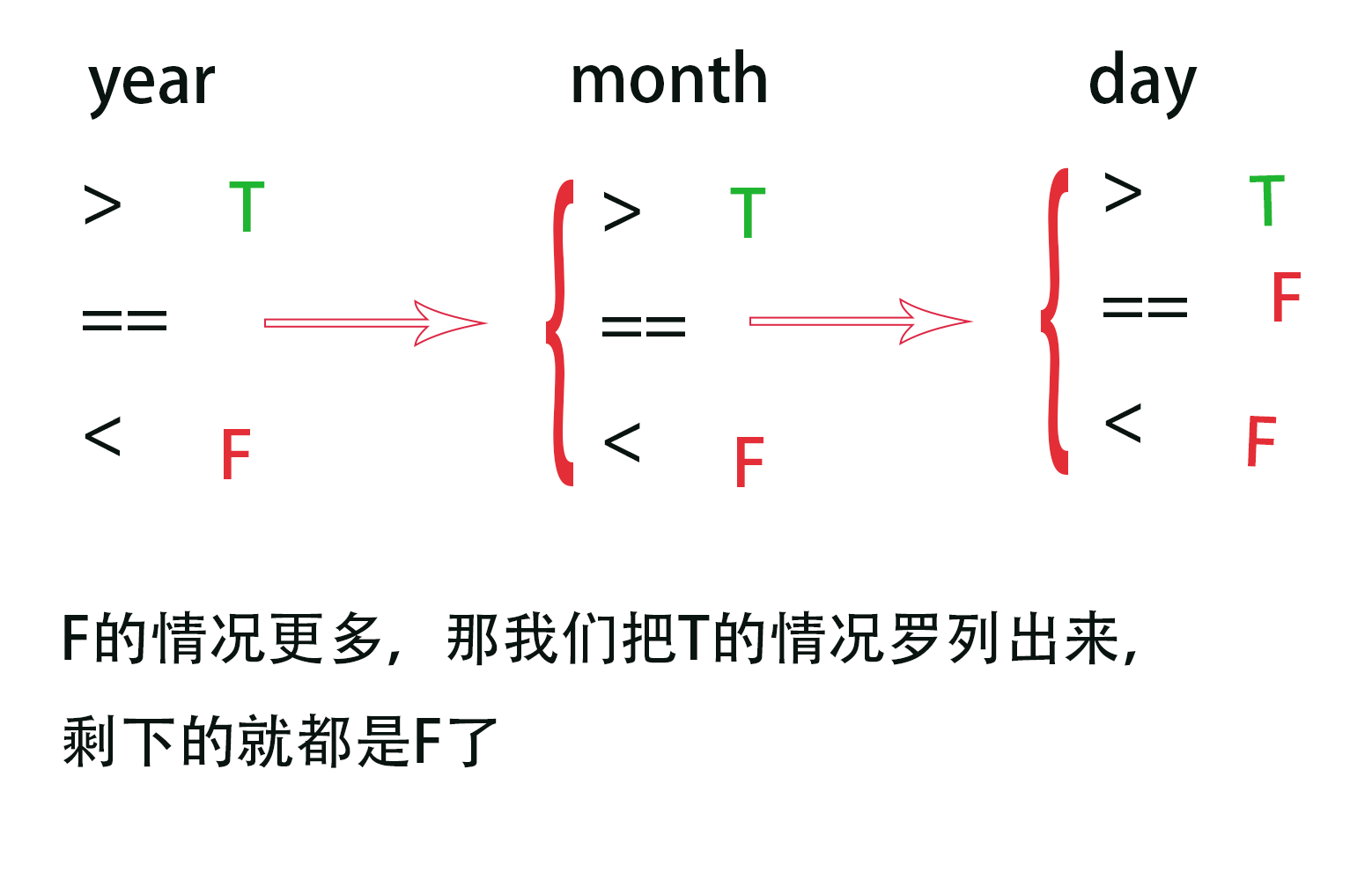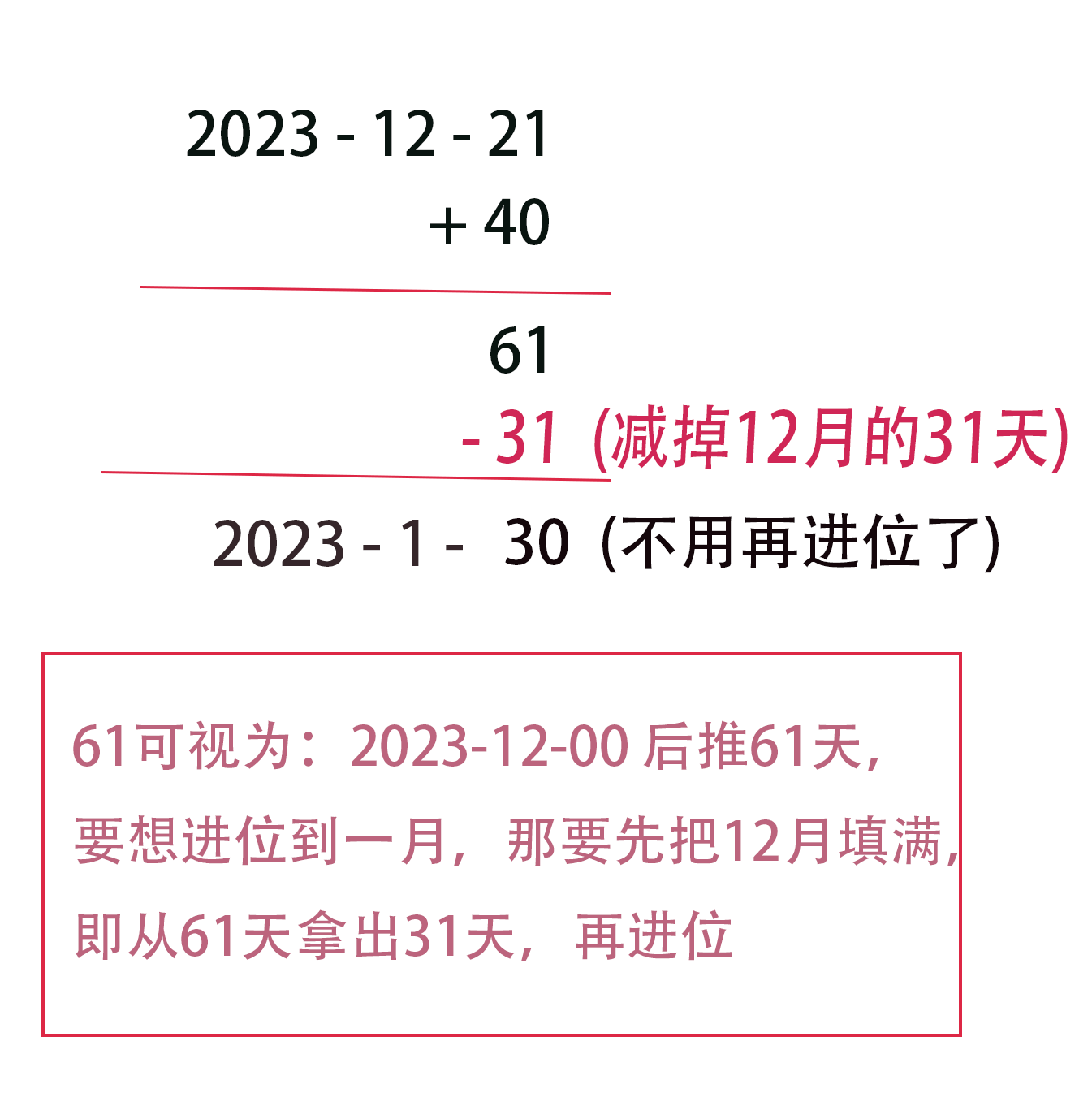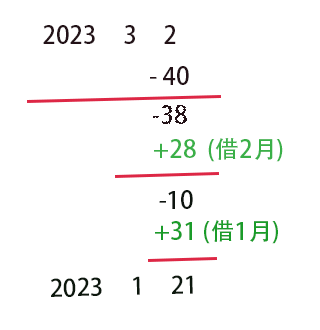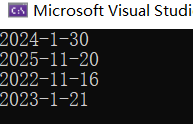【C++小项目】实现一个日期计算器
目录
Ⅰ. 引入
Ⅱ. 列轮廓
Ⅲ. 功能的实现
构造函数
判断是否相等 == | !=
➡️==:
➡️!=:
判断大小 > | >= | < | <=
➡️>:
➡️<=:
➡️>=:
➡️<:
加减天数 + | += | - | -=
➡️+=:
➡️+:
➡️-:
➡️-=:
自增/自减 ++ | --
➡️前置++
➡️后置++
➡️前置--
➡️后置--
日期减日期
➡️Way1(推荐)
➡️Way2( 这个思路繁杂很多)
Ⅰ. 引入
本篇我们用C++来实现一个日期计算器。
想知道迄今为止你在地球上一共度过了多少天吗?距离寒假还有多少天呢?一百天后会是几月几号呢?
解开这些问题的答案,只需来写一个日期计算器~👻
日期计算器是C++入门以来的第一个小项目,亲自实践一遍,我们在C++上的经验值将⬆️⬆️⬆️

🚩我们将分三步:
Step1:在头文件中把日期类的大体轮廓列出来
Step2:把声明的功能一一实现
Step3:逐个测试。我们写一点,测一点。
这样,就可顺利把日期计算器写出个七七八八。
在遇到较复杂的算法时,我会提供思路。
至于某些锦上添花的功能,我们后续想到了,再添上去。
Ⅱ. 列轮廓
🤔我们先来定义一个日期类,同时看看要实现哪些功能:
#pragma once
#include<iostream>
using namespace std;
class Date {
public:Date(int year = 1900, int month = 1, int day = 1); //构造函数:用于初始化
void Print(); //打印日期,便于测试
//功能的具体实现bool operator==(const Date& d); //判断俩date是否相等bool operator!=(const Date& d);
bool operator>(const Date& d); //date间比较大小bool operator>=(const Date& d);bool operator<(const Date& d);bool operator<=(const Date& d);
Date operator+(int day); //加(减)天数,今夕是何年Date& operator+=(int day);Date operator-(int day);Date& operator-=(int day);
Date& operator++(); //date的自增/自减Date operatoe++(int);Date& operator--();Date operatoe--(int);
int operator-(const Date& d); //算两个date间差多少天
private:int _year;int _month;int _day;
};Ⅲ. 功能的实现
构造函数
➡️我们实现一个全缺省的构造函数:
class Date{
public:Date(int year = 1900, int month = 1, int day = 1) { _year = year;_month = month;_day = day;}private:int _year;int _month;int _day;
}每次实例化出一个对象,都要调用构造函数,调用频率非常高。
所以,我们干脆就把这短短的几行定义在类里,做内联函数。
❓你可能会疑惑:为啥_year可以直接拿来用,不需要this->year嘛?
后者当然可以写,但没必要。因为我们在使用类的成员函数or成员变量时,this指针会默认加上的。
我们就不用一一手动加啦✌
➡️Print,写在Date.c里:
void Date::Print() {printf("%d-%d-%d\n", _year, _month, _day);
}❓为啥要加Date::呢?
要知道,类定义了一个全新的作用域。类里类外,是有一层屏障的。
正因为类域的存在,我们不能直接从外部访问类的成员。
因此,把成员函数拿到类外定义时,要指明作用域,即加上Date::
❓我们不是学了cout嘛,为啥不直接cout输出,还得用printf?
这个问题我们先保留着,下一趴再讲。🤪
🔬🧪这俩函数先测试一波:
void Test1() {Date d1(2023, 8, 23);Date d2;d1.Print();d2.Print();
}
int main()
{Test1();return 0;
}结果:

判断是否相等 == | !=
➡️==:
bool Date::operator==(const Date& d) {return _year == d._year&& _month == d._month&& _day == d._day;
}➡️!=:
bool Date::operator!=(const Date& d) {return !(*this == d);
}有没有发现,其实我们只实现了==,
写!=时直接套用了==的功能,这叫做复用。
复用可以减少工作量,提高代码的重用性。
❓为啥只有一个形参?
其实有两个形参:第一个形参是隐形的:this指针。只有第二个形参可见。
“d1!=d2; ” 就相当于在调用函数 “d1.operator!=(d2); ”
此函数的this指针指向d1,形参的d即d2。
🔬🧪测试一下:
void Test2() {Date d1(2023, 8, 23);Date d2(2000, 1, 1);if (d1 != d2) {cout << "unequal"<<endl;}
}
int main()
{//Test1();Test2();return 0;
}结果:

判断大小 > | >= | < | <=
日期的大小,听着蛮抽象。其实就是日期的先后:2023年1月1日比2000年1月1日要大(后)。
➡️>:
bool Date::operator>(const Date& d) {if (_year > d._year|| _year == d._year && _month > d._month|| _year == d._year && _month == d._month && _day > d._day) {return true;}else {return false;}
}这种算法的思路是:

写完>,先不急着写<,因为>的对立面是<=,那我们可以把这段代码复用到<=👻
➡️<=:
bool Date::operator<=(const Date& d) {return !(*this > d);
}➡️>=:
bool Date::operator>=(const Date& d) {return *this > d || *this == d;
}➡️<:
bool Date::operator<(const Date& d) {return !(*this >= d);
}🔬🧪测试一下:
void Test3() {Date d1(2023, 8, 23);Date d2(2000, 1, 1);cout << (d1 > d2) << endl;cout << (d1 <= d2)<<endl;
}
int main()
{//Test1();//Test2();Test3();return 0;
}结果:

加减天数 + | += | - | -=
➡️+=:
日期加天数要考虑进位的问题。我举个例子,先顺下思路:
2023-12-21往后推40天

61相比当月的31已经溢出了,
怎么判断是否溢出呢?
写个函数GetMonthDay(),取到每月的天数进行比对
GetMonthDay()实现如下:
int Date::GetMonthDay(int year, int month) {int days[13]={ 0, 31, 28, 31, 30, 31, 30, 31, 31, 30, 31, 30, 31};int ret = days[month];
//考虑闰年的2月是29天的情况//闰年,要么能被4整除&&不能被100~;要么能被400整除
if (month == 2&& (year % 4 == 0 && year % 100 == 0|| year % 400 == 0)) {ret += 1;}
return ret;
}☑️operator+=实现如下:
Date& Date::operator+=(int day) {_day += day;int MaxDay = GetMonthDay(_year, _month);
while (_day > MaxDay) {_day -= MaxDay;_month++;
//防止month溢出if (_month == 13) {_month = 1;_year++;}
MaxDay = GetMonthDay(_year, _month);}
return *this;
}➡️+:
有了+=,+就直接复用~👻
Date Date::operator+(int day) {Date ret = *this;ret += day;return ret;
}🤔❓思考:为啥不能这样写?
Date Date::operator+(int day) {Date ret = *this+day;return ret;
}因为:
➡️-:
加要考虑进位,减要考虑借位。
举例:2023-3-2 往前40天
思路:

🌀你可能有点晕:-38为什么要借2月的28?
可以把2023-3-2往前40天视为2023-3-0往前38天。
此时要借位,我们没法从3月借,因为它是空的。只能从2月借。
☑️实现:
Date& Date::operator-=(int day) {_day -= day;
while (_day <= 0) {_month--;
if (_month == 0) {_month = 12;_year--;}int BorrowDay = GetMonthDay(_year, _month);_day += BorrowDay;}
return *this;
}➡️-=:
同样,复用🥰
Date Date::operator-(int day) {Date ret = *this;ret -= day;return ret;
}🔬🧪测试一下:
void Test4() {Date d1(2023, 12, 21); //+ +=Date d2(d1);(d1 + 40).Print();(d2 += 700).Print();Date d3(d1); //- -=Date d4(2023, 3, 2);(d3 -= 400).Print();(d4 - 40).Print();
}结果:

自增/自减 ++ | --
我们用参数占位来区分前置/后置++:
前置:operator++( )
后置:operator++( int )
❓前置++和后置++的区别是什么?
这俩都能实现自增,但返回值不同。
前置:++d; 先加加,再使用。返回的是加加后的值。
后置:d++;先使用,再加加。返回的是加加前的值。
假设d=0,d++:返回1,d=1
++d:返回0,同时实现自增,d=1
所以说,后置加加是不能引用返回的。而前置可以。
➡️前置++
Date& Date::operator++() {return *this += 1;
}➡️后置++
Date Date::operator++(int) {Date ret = *this;*this += 1;return ret;
}➡️前置--
Date& Date::operator--() {return *this -= 1;
}➡️后置--
Date Date::operator--(int) {Date ret = *this;*this -= 1;return ret;
}🔬🧪测试一下:
void Test5() {Date d1(2023, 1, 1); //++Date d2(d1);(++d1).Print();(d2++).Print();
Date d3(2023, 1, 1); //--Date d4(d3);(--d3).Print();(d4--).Print();
}结果:

日期减日期
距离新年还有多少天呢?
Date(2024,1,1) - Date(2023,8,24) =❓天
➡️Way1(推荐)
我们刚刚不是写了好多功能嘛,复用起来~👻
实现:
int Date::operator-(const Date& d) {Date More = *this; //先把date标个大小Date Less = d;
if (Less > More) {More=d;Less=*this;}
int count = 0; //用计数法算差值while (Less<More) {Less++; //复用🥰👻count++;}
int flag = 1; //我们不知道是大-小or小-大if (More == d) { //为了区分结果的正负,引入flagflag = -1; }
return count*flag;
}这种方法虽然思路简单,但是深度复用了代码,效率会下降。
➡️Way2( 这个思路繁杂很多)
(❗这个方法效率会⬆️,但是较复杂,可略过不看!)
Q: 2023-2-13到2024-1-15,要过多少天?、
思路:
Step1:把月、日转化成总天数;
Step2:年与年之间相减,天与天之间相减
Step3:全化成天

实现:
Step1 我们先写一个把月、日转换成天数的函数ConverttoDay( )
如下:
int Date::ConverttoDay(int year, int month, int day) {int MonthtoDay = 0;month -= 1;
while (month) {MonthtoDay += GetMonthDay(year, month);month--;}
int ret = MonthtoDay + day;return ret;
}Step2 实现operator-函数
int Date::operator-(const Date& d) {//先判断日期的大小Date BigDate = *this;Date SmallDate = d;
if (BigDate < SmallDate) {Date tmp = SmallDate;SmallDate = BigDate;BigDate = tmp;}
//把月、日都转换成天int BigDay = ConverttoDay(BigDate._year, BigDate._month, BigDate. _day);int SmallDay = ConverttoDay(SmallDate._year, SmallDate._month, SmallDate._day);
int RetofDay = BigDay - SmallDay; //天之间相减,大天-小天int BigYear = BigDate._year;int SmallYear = SmallDate._year;
//年之间相减,大年-小年int CountDay = 0;
while (SmallYear < BigYear) {CountDay += 365;
if (SmallYear % 4 == 0 && SmallYear % 100 != 0 //考虑闰年|| SmallYear % 400 == 0) {CountDay += 1;}
SmallYear++;}
//把两者的天数合一int ret = RetofDay + CountDay;
int flag = 1;if (*this == BigDate) {flag = -1;}
return flag * ret;
}🔬🧪测试一下:
void Test6() {Date d1(2023, 8, 24);Date d2(2024, 1, 1);
printf("%d\n", d2 - d1);
}结果:

OK, 到这我们的日期计算器已经完成啦~🥰👻
